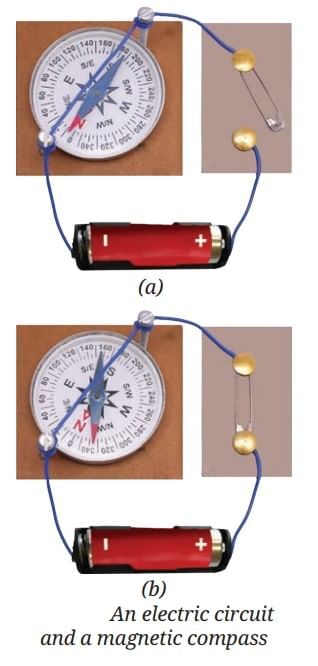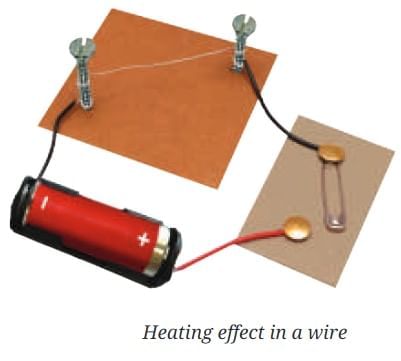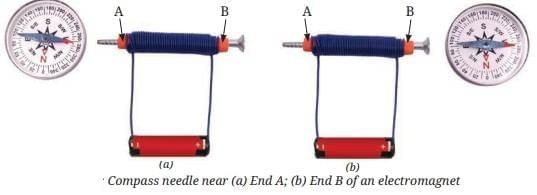Important Diagrams: Electricity: Magnetic and Heating Effects | Science Class 8 PDF Download
Q: Answer the following questions based on the diagram given below:
(i) What components are shown in the diagram for demonstrating the magnetic effect of electric current?
Ans: The diagram shows an electric cell in a cell holder, a switch made with drawing pins and a safety pin, a long wire stretched between two nails on a cardboard, a magnetic compass placed beneath the wire, and connecting wires forming a circuit.
(ii) Define the magnetic effect of electric current based on the diagram.
Ans: The magnetic effect of electric current, as shown in the diagram, is the phenomenon where a current-carrying wire produces a magnetic field, causing the deflection of a nearby magnetic compass needle when the circuit is closed.
(iii) How does the diagram illustrate the behavior of the magnetic compass when the circuit is switched on and off?
Ans: The diagram shows that when the switch is turned on, the current flows through the wire, deflecting the compass needle due to the magnetic field. When the switch is turned off, the current stops, and the needle returns to its original position.
(iv) What happens to the compass needle in the diagram when the switch is in the OFF position?
(a) It deflects to the left
(b) It deflects to the right
(c) It remains in its original position
(d) It spins continuously
Ans: (c)
The diagram indicates that when the switch is off, no current flows, so the magnetic field disappears, and the compass needle remains in its original position.
(v) What is the significance of the observation shown in the diagram for understanding electricity and magnetism?
Ans: The diagram demonstrates that electric current produces a magnetic field, revealing the link between electricity and magnetism, which is crucial for designing devices like electromagnets, motors, and generators used in everyday life.
Q2: Answer the following questions based on the diagram given below:
 (i) What components are shown in the diagram to demonstrate the heating effect of electric current?
(i) What components are shown in the diagram to demonstrate the heating effect of electric current?
Ans: The diagram shows a nichrome wire tied between two nails on a cardboard, an electric cell in a cell holder, a switch, and connecting wires forming a circuit to pass current through the nichrome wire.
(ii) Define the heating effect of electric current based on the diagram’s context.
Ans: The heating effect of electric current, as depicted in the diagram, is the phenomenon where a conductor, like a nichrome wire, becomes warm due to resistance converting electrical energy into heat when current flows through it.
(iii) How does the diagram illustrate the change in the nichrome wire when the switch is turned on?
Ans: The diagram shows that when the switch is turned on, current flows through the nichrome wire, causing it to heat up due to its high resistance, which can be felt by observed to heat up after 30 seconds.
(iv) Which of the following materials is used in the diagram to demonstrate the heating effect?
(a) Copper wire
(b) Nichrome wire
(c) Aluminium wire
(d) Iron wire
Ans: (b)
The diagram uses a nichrome wire, which has high resistance, to demonstrate the heating effect by warming up when current flows through it.
(v) What is the significance of the heating effect shown in the diagram for practical applications?
Ans: The heating effect, as shown in the diagram, is used in household appliances like electric heaters, stoves, and irons, where high-resistance wires like nichrome generate heat for cooking, heating, or ironing, improving convenience and efficiency.
Q3. Answer the following questions based on the diagram given below:

(i) What is the purpose of the compass needle in the diagram?
Ans: The compass needle is used to detect the magnetic field around the electromagnet. It aligns itself with the magnetic field lines, pointing towards the north pole of the magnetic field created by the electromagnet, helping to identify the direction and strength of the magnetic field at ends A and B.
(ii) How does the position of the compass needle differ when placed near end A compared to end B of the electromagnet?
Ans: The position of the compass needle differs because the magnetic poles at ends A and B are opposite. Near end A, the needle points in one direction (e.g., north), indicating that A might be the north pole, while near end B, it points in the opposite direction (e.g., south), suggesting B might be the south pole, depending on the direction of the current.
(iii) What does the diagram suggest about the nature of ends A and B of the electromagnet?
Ans: The diagram suggests that ends A and B of the electromagnet act as magnetic poles. When current flows through the coil, it creates a magnetic field, with one end (e.g., A) behaving as the north pole and the other (e.g., B) as the south pole, similar to a bar magnet, depending on the direction of the electric current.
(iv) What role does the battery play in the setup shown in the diagram?
Ans: The battery provides the electric current that flows through the coil of wire wrapped around the iron core. This current generates a magnetic field around the coil, transforming the iron core into an electromagnet with poles at ends A and B, which in turn affects the orientation of the compass needle.
(v) Explain why the compass needle moves when placed near the electromagnet.
Ans: The compass needle moves because it is a small magnet that responds to the magnetic field produced by the electromagnet. When the current flows through the coil, it creates a magnetic field that interacts with the needle’s own magnetic field, causing it to align with the field lines, thus indicating the polarity and direction of the electromagnet’s magnetic field.
|
92 videos|296 docs|44 tests
|
FAQs on Important Diagrams: Electricity: Magnetic and Heating Effects - Science Class 8
| 1. What are the magnetic effects of electricity? |  |
| 2. How does the heating effect of electricity work? |  |
| 3. What is an electromagnet, and how is it made? |  |
| 4. What are some applications of the magnetic and heating effects of electricity? |  |
| 5. How can the magnetic effects of electricity be demonstrated through experiments? |  |





















